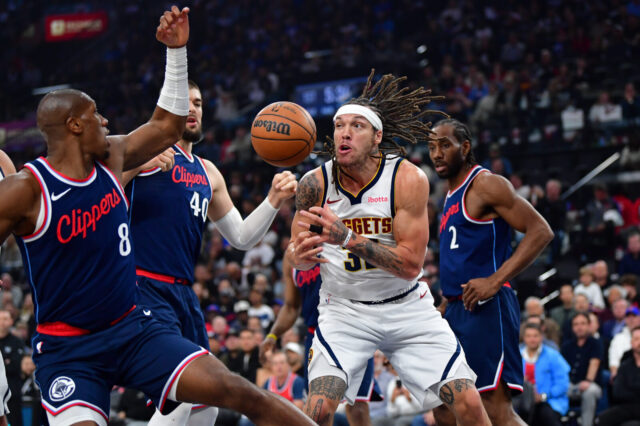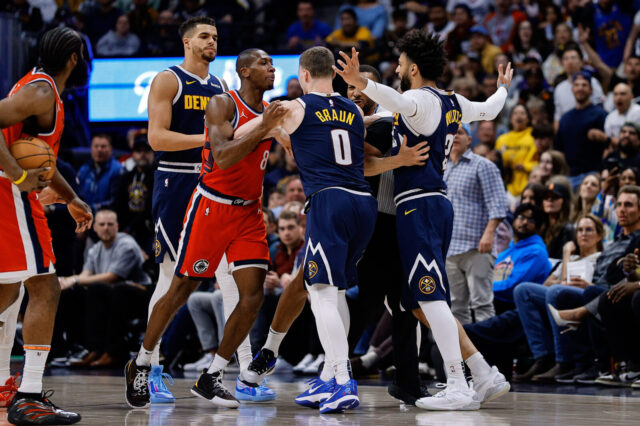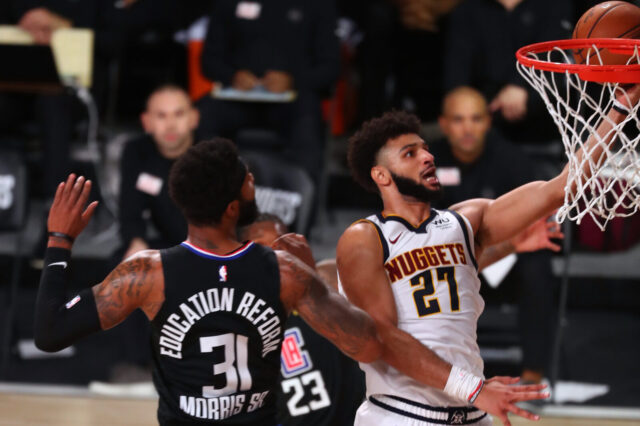I’m on the tail end of a near seven-year stint living in Utah. I’ve loved my time here – Utah is a great place to live with endless options of things to do. It’s been nice, but it’s time to move on. And with the end of my time here coinciding with the resurgent Jazz in the playoffs, I can’t help but reflect on how my views of the team has changed. Though I have never really cared for them as a Nuggets fan, I have grown to admire the dedicated fanbase and have especially been impressed with how the franchise is quickly becoming a relevant, despite facing many of the struggles that plague small-market teams.
My entire time in Utah has been marked by the Jazz’s fall from grace and their entire rebuild, up until this season when Utah won 51 games and secured the fifth seed. I first moved to Utah in 2010, shortly after the Jazz defeated the George Karl-less Nuggets in the first round. Despite the animosity, things were looking up for both teams. The following season, however, Utah fell apart. Hall of Fame coach Jerry Sloan retired halfway through the season, and just weeks later franchise point guard Deron Williams was shipped off to New Jersey. The Jazz rebuild had begun.
In the six years since Sloan’s departure I have not had one reason to ever question a Jazz fan’s fandom, even in 2013-2014 when the team won just 25 games. Utah loves the Jazz and are by no means bandwagon fans. They really are “homers”, as Chris Paul would say. Utah’s attendance numbers back that up. Throughout the entire Jazz rebuild from 2010-2011 to 2016-2017, the team has been top ten in attendance every year except for 2013-2014 when it placed 12th. Four of those six years the Jazz finished under .500 and missed the playoffs.
The Nuggets’ attendance records paint a completely different picture. At best, in the 2012-2013 season when Denver won 57 freaking games, it finished just 14th in the league in attendance. Since George Karl was fired and the Nuggets began a rebuild of their own, attendance has dropped to among the worst in the NBA, even finishing dead last for two years running now. This season, as a fringe playoff team, those numbers are embarrassing and unacceptable.
How does Utah do it, then? The cop-out answer is to say that compared to Denver, Utah only has one major sports team to cheer for. This short-sighted school of thought would say, “The Broncos will always reign supreme in Denver and the Rockies own Colorado summers, but Utahns don’t have anyone else besides the Jazz.” And so even on a weekday night in the winter in the middle of a losing season, fans will show up and cheer hard.
But the notion that Utah simply doesn’t have anyone else to cheer for does a great disservice to all that the Jazz franchise has done to get the team and Salt Lake City where they are today. Short of landing talents like Kevin Durant and Russell Westbrook in the draft a la Oklahoma City, or hiring a complete mastermind like Gregg Popovich in San Antonio (though Sloan does come close), the Jazz in recent years has done absolutely everything right in order to make a small market team successful. And I’m not just talking about on the court. The Utah Jazz franchise is and should be the model that other small market teams like the Denver Nuggets should emulate.
Of course, the most important thing the Nuggets can do to stay relevant is put a consistently winning product on the floor. Winning is the only way to compete with the Broncos. It’s not impossible – the Colorado Avalanche owns the NHL record for most consecutive home sellouts, amazingly by selling out 487 straight games over 11 years. But the Avs did it by winning two Stanley Cups in the process, and since that streak ended in 2006 they too have suffered in attendance numbers as the team has gone from a perennial contender to a bottom-feeder.
Last season the Jazz finished with a 40-42 record and fell just short of the playoffs, the exact same position the Nuggets currently find themselves in. Much like Denver has done with Nikola Jokic, Utah had already discovered the core to build around in Gordon Hayward and Rudy Gobert. And so last summer, Dennis Lindsey got to work by acquiring veterans George Hill, Joe Johnson and Boris Diaw to fill the need for depth and leadership. The results for Utah have been tremendous.
The next step for Denver will be to make similar decisions. The Nuggets are in a peculiar position as they have plenty of young talent waiting on the roster, but also have enough veterans that are potentially good enough to lead the team to the postseason next year. Right now Denver’s glaring need is perimeter defense. Is Danilo Gallinari the key player to retain in free agency, should he opt-out of his contract? Are there other veteran players who are plus-defenders that the team could bring in? Or should Denver ride the younger players like Jamal Murray, Juancho Hernangomez, Emmanuel Mudiay and Malik Beasley and turn more towards the future instead? The trick for the Nuggets will be to maintain some sort of relevancy now while developing the gold mine of talent they are already sitting on.
While Denver has questions to answer on the basketball court, it also has important questions to answer off of it. And that’s where the Utah model comes in.
The Jazz may be the only major pro sports team in Utah, but the franchise has invested A LOT into Salt Lake City and the state of Utah, and it’s been that way since the late Larry H. Miller purchased the team in the 1980s. Miller was able to keep the Jazz in Utah by going $22 million into debt, a huge gamble but one he felt necessary to take. He considered the team “a gift to Utah” and then proceeded to turn his gift from a struggling team into a financially profitable powerhouse while simultaneously boosting the Salt Lake economy by building a new arena downtown.
In addition to making the Jazz a successful business, Miller also created a team culture that enabled players and coaches to want to stay in Utah. Miller was a huge proponent of loyalty and stability – and he stuck with those he trusted. How else could generational talents like John Stockton and Karl Malone play so many years together, or coach Sloan remain with the Jazz for 23 seasons? Utah was rewarded with one of the most consistent and winningest teams in all of pro sports – 22 playoff appearances in 25 seasons – and two NBA Finals appearances. Denver’s 10 consecutive playoff births thanks to Carmelo Anthony and George Karl hardly stand in comparison.
Even after Miller’s passing in 2009, the immense loyalty for the state of Utah continues. Earlier this year, Gail Miller, Larry’s wife and owner and chair of the Larry H. Miller Group, announced that she has transferred ownership of the Jazz and Vivint Smart Home Arena to a family owned legacy fund, a move never before seen in professional sports ownership, and one that essentially guarantees that the Jazz will always remain in Utah. For smaller market teams, including Denver, there will always be a fear of becoming the next Seattle Supersonics – uprooted and transferred to a new city. Utah no longer has that fear.
In addition to the franchise stability, this legacy trust will benefit the organization financially for years to come. According to former Jazz president Dennis Haslam, "The profit that stays in the company will be used basically as retained earnings for expansion, for player salaries or other operations." The trust will not be used to benefit the Miller family materially, meaning Utah has another tool available to help keep the franchise relevant for both players and the fans.
This benefit is already being put to work. Last year, the Miller Group announced plans to completely renovate Vivint Smart Home Arena, a $125 million project. According to the announcement, “the renovation includes planned upgrades on all six levels of Vivint Smart Home Arena and includes the addition of a 12,000 square-foot atrium to help fans get out of the elements as they move through security, new suites and lounges for fans, and a revamped locker room and other amenities aimed at attracting and keeping players.”
In addition to the aforementioned improvements, the Jazz are continuing their investment in local companies by focusing the arena’s food renovation on local Utah restaurants. Many of the 30+ dining options that will be available for patrons are homegrown Utah favorites.
The Nuggets currently play at Pepsi Center, which at the time of its opening in 1999 was considered a state of the art arena. 18 years later, however, its easy to see how sometime in the near future upgrades will need to be made in order to keep with the trends and to provide a much better fan experience. Fortunately for the Nuggets and Avalanche, Kroenke owns plenty of real estate around Pepsi Center which could make transformation of the area into a full-fledged entertainment area downtown a real possibility. What the Jazz are doing to Vivint Smart Home Arena, as well as Sacramento’s new Golden 1 Center, should certainly serve as a model for whatever changes are made to Pepsi Center and the surrounding area in the near future.
On top of the renovations, the Jazz are also leading the way when it comes to handling corporate sponsorships. In 2016, the NBA approved the sale of jersey sponsorships, which will result in teams being able to place corporate logos on a 2.5 by 2.5 inch jersey patch this upcoming season. While some teams were quick to strike deals with well-known corporate sponsors, such as the Boston Celtics (General Electric) and Philadelphia 76ers (StubHub), the Jazz took a completely different approach by renouncing the typical corporate sponsorship and in favor of a non-profit by selling the spot to Qualtric’s (again – a local business) cancer research and fundraising charity, Five For The Fight.
This innovative and philanthropic move by the Jazz is an absolute home run. 5 For The Fight aims to motivate everybody to donate $5 to cancer research, with the goal of raising at least $50 million. Gail Miller has made this goal a lot more obtainable. “I’m grateful that the Utah Jazz can provide a platform to reach out to so many people,” Miller told Deseret News. “It really does reflect who we are at the Larry H. Miller Group of Companies because as we do business we understand we have an obligation to enrich lives and to make the world a better place, and this certainly will do that.”
The Denver Nuggets have yet to announce a sponsor for the jersey patch, but clearly something like this is the way to go to establish more goodwill.
Another area where the Jazz have excelled is its branding – a spot where clearly the Nuggets need to improve. Denver has had the same powder blue and yellow logos and jerseys since the early 2000s, with only a few minor tweaks in between. Utah, on the other hand, refreshed its logos and colors this season, moving away from the mountain design and sticking with the classic musical note in a modern upgrade. As far as we know, Denver has no plans to make any major overhauls to the Nuggets logo and color schemes, but it’s something that is long overdue.
Finally, back to player development. In 2015, the Jazz purchased the D-League’s Idaho Stampede, moving the team to Salt Lake City for the start of the 2016-17 season. The Salt Lake City Stars now provide a direct avenue for younger players to develop and closely associate with the Jazz system of basketball, instead of merely riding the bench or being shipped back and forth between a separate D-League team throughout the season.
In today’s NBA, team owned D-League affiliates are an absolute must, especially considering that the new CBA allows teams to develop two players in the D-League on two-way contracts, effectively increasing the maximum roster size to 17 from 15. To the surprise of no one, Denver has fallen way short. The Nuggets are one of a small handful of teams who don’t own a D-League affiliate, though reports indicated that the team is “likely to get back into the D-League business next season” though as of October 2016, nothing was “decided or imminent.”
In my opinion, this is the one area where Denver has failed the most. The past few years have been dedicated to a rebuild and to developing young talent, but instead of providing an opportunity for rookies to get playing time with an associated team, these guys have been glued to the bench. Only Malik Beasley has really benefited from the D-League, but to be honest it looked ridiculous for Denver to parlay him to and from Sioux Falls time and time again this season. Imagine how much better he and Juancho Hernangomez, or even Emmanuel Mudiay, could be had they had a real opportunity to play for a Denver D-League team this season (and next season?). The face of the NBA is changing and the D-League will soon be a legitimate minor league system for teams, but once again the Nuggets will be far behind the competition.
The Utah Jazz is not a perfect franchise or a team that will be contending for a championship this season. But it is an organization that is making the most of its situation as a small-market team by investing in its city, its fans and its players in new and innovative ways. These investments are already paying off and will do so even more in the future as players will find Utah a more attractive destination. For another small-market team that is trending up in the Nuggets, and one that struggles with relevancy and attendance within its own city, the Jazz has provided a model for how to build a successful organization from the top down. The Nuggets’ first priority should always be to put the best product on the court, but taking a page or two out of the Jazz’s book could also revolutionize the organization and its appearance within Denver and around the NBA.
This content is no longer available.


